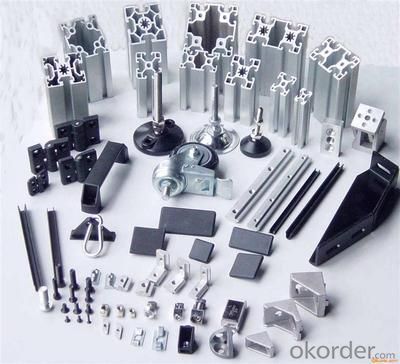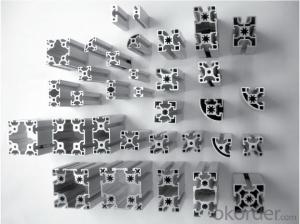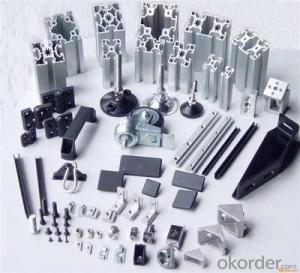Shower Room OEM Aluminum Extrusion for high voltage Switchgear
- Loading Port:
- Guangzhou
- Payment Terms:
- TT OR LC
- Min Order Qty:
- 5 m.t.
- Supply Capability:
- 1000 m.t./month
OKorder Service Pledge
OKorder Financial Service
You Might Also Like
Item specifice
1.Structure of Shower Room OEM Aluminum Extrusion for high voltage Switchgear Description:
Anodizing (also spelled anodising, particularly in the UK and Australia) is an electrolytic passivation process used to increase the thickness of the natural oxide layer on the surface of metal parts. Anodized aluminium surfaces, for example, are harder than aluminium but have low to moderate wear resistance that can be improved with increasing thickness or by applying suitable sealing substances.
2.Main Features of the Shower Room OEM Aluminum Extrusion for high voltage Switchgear:
High corrosion-resistance;
weather-resistance;
heat-resistance;
alkali-resistance and impact-resistance properties.
3.Shower Room OEM Aluminum Extrusion for high voltage Switchgear Images:



4.Aluminium Profile for Cars Auto-parts Good Quality Specification:
1. Material: 6063,6061,6060,6005,6005A,etc.
2. Temper: T5 or T6
3. Finish: Mill finish, anodizing, powder coating, electrophoresis, wooden transfer or pvdf/carbon-flouride coated, polishing, brushing, sand blasting
4. Various colors: Silver, bronze, black, gold, blue, grey, champagne, bright, etc.
5. Machining: Cutting, punching, drilling, tapping, milling, bending, welding, CNC etc.
5.FAQ:
①How about your company?
A world class manufacturer & supplier of castings forging in carbon steel and alloy steel,is one of the large-scale professional investment casting production bases in China, consisting of both casting foundry forging and machining factory. Annually more than 8000 tons Precision casting and forging parts are exported to markets in Europe, America and Japan. OEM casting and forging service available according to customer’s requirements.
②How to guarantee the quality of the products?
We have established the international advanced quality management system,every link from raw material to final product we have strict quality test;We resolutely put an end to unqualified products flowing into the market. At the same time, we will provide necessary follow-up service assurance.
- Q:Are there any regulations or standards that aluminum profiles must meet?
- Yes, there are several regulations and standards that aluminum profiles must meet in order to ensure their quality and safety. These regulations and standards vary depending on the specific application and industry, but some common ones include: 1. ISO Standards: The International Organization for Standardization (ISO) has developed various standards for aluminum profiles, such as ISO 9001 for quality management systems, ISO 14001 for environmental management systems, and ISO 9001 for occupational health and safety management systems. 2. ASTM International Standards: ASTM International provides standards for aluminum profiles used in construction, transportation, and other industries. These standards outline the chemical composition, mechanical properties, and dimensional tolerances that aluminum profiles must meet. 3. American National Standards Institute (ANSI) Standards: ANSI develops standards for aluminum profiles used in various applications. These standards cover aspects such as design, performance, and safety requirements. 4. European Standards (EN): In Europe, aluminum profiles must meet the requirements of the European Committee for Standardization (CEN). These standards define the characteristics, dimensions, and tolerances of aluminum profiles used in construction, aerospace, automotive, and other industries. 5. National Regulations: Many countries have their own regulations governing the use of aluminum profiles. These regulations may cover aspects such as fire safety, structural integrity, and environmental impact. It is important for manufacturers, suppliers, and users of aluminum profiles to adhere to these regulations and standards to ensure the quality, reliability, and safety of their products and applications. Compliance with these standards helps to maintain consistency, interoperability, and customer confidence in the use of aluminum profiles across various industries.
- Q:You need is the extrusion machine section now has Liaoning Zhong Wang Liaoyuan Midas Nanshan aluminum aluminum Hunan Sheng Guangxi jungle SWA South northeast light alloy etc. they have more than 4500 tons of extrusion machine mainly produces large section comprises a track body profile LED lamp shell container ship with large cross section conductor rail section I is a seamless tube a market analyst if you have aluminum industrial material need to be aware of the problem you can consult me as friends.
- Our company has several 1100 ton extruders, but I feel all right
- Q:What are the top 20 Chinese architectural aluminum profiles?
- 14, Fujian public security Aluminum Co. Ltd.15, Zhejiang pillars of new material Limited by Share Ltd16, Lear aluminum industry Limited by Share Ltd17 、 Ming emperor Aluminum Industry Co., Ltd.18, Guangdong silver100 innovation Aluminum Co. Ltd.19 、 Qingyuan Asia Aluminum Co., Ltd.20 、 Guanghan Sichuan Sanxing Aluminium Industry Co., Ltd.
- Q:Are aluminum profiles suitable for use in mining and construction equipment?
- Indeed, mining and construction equipment can benefit from the utilization of aluminum profiles. The unique properties of aluminum make it highly compatible with these industries. Firstly, its lightweight nature aids in reducing the overall weight of the equipment, facilitating easy transportation and maneuverability on construction sites or during mining operations. Moreover, this lightweight characteristic enhances fuel efficiency, thereby decreasing operational costs. Furthermore, aluminum profiles possess exceptional resistance to corrosion, a vital attribute for these industries, where equipment is frequently exposed to severe weather conditions and corrosive substances. This corrosion resistance guarantees the durability and longevity of the equipment, even in challenging environments. Additionally, aluminum profiles offer ease of fabrication and customization to cater to specific requirements. This adaptability in design permits the creation of intricate shapes and structures, enabling the construction of equipment with optimal strength and functionality. Moreover, the high thermal conductivity of aluminum profiles effectively dissipates heat generated during mining and construction operations. This property plays a crucial role in preventing overheating or damage to the equipment, ensuring efficient performance even in intense working conditions. In summary, the combination of lightweight, corrosion resistance, versatility, and thermal conductivity renders aluminum profiles a suitable choice for integration into mining and construction equipment.
- Q:Aluminum bending die, iron must be used, what iron should be used, specifically what brand?
- General production of aluminum alloy is H13, die steel, if stretched or squeezed, most are carbide. I work in the production of aluminum profiles
- Q:Are aluminum profiles suitable for furniture applications?
- Indeed, furniture applications can benefit from the use of aluminum profiles. Aluminum, known for its versatility and lightweight nature, offers numerous advantages in furniture design and construction. To begin with, aluminum profiles boast exceptional strength and durability, making them the perfect fit for furniture that endures regular use and bears weight. Moreover, their resistance to corrosion allows for their usage both indoors and outdoors, without the worry of rusting or deterioration over time. Furthermore, aluminum profiles provide design flexibility. They can be effortlessly molded and shaped into various forms and sizes, allowing for the creation of innovative and unique furniture designs. Additionally, aluminum profiles can be extruded into diverse profiles and sections, enabling customization and adaptation to different furniture styles and requirements. Additionally, aluminum is an environmentally friendly material that can be recycled repeatedly without compromising its properties. This sustainable feature makes it an ideal choice for furniture applications. In conclusion, aluminum profiles offer a blend of strength, durability, versatility, and sustainability, making them highly suitable for a wide range of furniture applications.
- Q:How do aluminum profiles perform in terms of impact resistance?
- Aluminum profiles generally exhibit good impact resistance due to their inherent strength and durability. They are capable of withstanding moderate to high impact forces without deforming or breaking easily. However, the specific impact resistance of aluminum profiles can vary depending on their thickness, alloy composition, and surface treatment.
- Q:Industrial aluminum profiles are generally used in what industry?
- Kunshan Austrian crown aluminum to tell you: mainly used in the manufacture of industrial production, such as automation equipment, covering the skeleton and the custom mold machinery and equipment according to their own requirements, such as assembly line conveyor belt, hoisting machine, glue machine, testing equipment, shelves and so on, electronic machinery industry and clean room with.
- Q:What are the advantages of using aluminum profiles in the marine industry?
- There are several advantages of using aluminum profiles in the marine industry. Firstly, aluminum is highly resistant to corrosion. When exposed to saltwater and other harsh marine environments, aluminum profiles do not rust like other metals such as steel. This makes it a reliable and durable material for various marine applications. Secondly, aluminum profiles are lightweight yet strong. This characteristic allows for easier handling and installation, reducing the overall weight of the vessel. This not only improves fuel efficiency but also increases the payload capacity of the boat, enabling it to carry more cargo or passengers. Additionally, aluminum profiles are highly customizable. They can be easily shaped, cut, and welded to meet specific design requirements. This flexibility allows for the creation of complex structures and intricate designs, providing architects and engineers with endless possibilities in marine construction. Furthermore, aluminum is a sustainable material. It is 100% recyclable and retains its properties even after multiple recycling processes. This makes it an environmentally friendly choice for the marine industry, aligning with the growing demand for sustainable practices. Lastly, aluminum profiles offer excellent thermal conductivity. This property allows for better heat dissipation, reducing the risk of overheating in marine applications. It also enables the efficient transfer of heat in cooling systems, enhancing the overall performance of marine engines and equipment. In conclusion, the advantages of using aluminum profiles in the marine industry include corrosion resistance, lightweight yet strong characteristics, customizability, sustainability, and excellent thermal conductivity. These benefits make aluminum profiles an ideal choice for various marine applications, contributing to the overall efficiency, durability, and environmental friendliness of marine vessels and structures.
- Q:How do you attach accessories or components to aluminum profiles?
- There are several ways to attach accessories or components to aluminum profiles. One common method is to use T-slot nuts and bolts. T-slot nuts slide into the T-slot groove on the profile and can be positioned anywhere along the length. The bolts then secure the accessory or component to the nut, creating a strong and secure connection. Another option is to use brackets or mounting plates specifically designed for aluminum profiles. These brackets usually have pre-drilled holes that align with the T-slot grooves, allowing for easy attachment of accessories. They can be fastened to the profile using screws or bolts. Additionally, there are various specialized connectors available for specific applications. Examples include corner connectors, joining plates, and hinge connectors. These connectors provide easy and reliable ways to attach accessories or components to aluminum profiles without the need for additional drilling or machining. It is important to consider the weight and load-bearing requirements of the accessories or components when choosing the attachment method. Using appropriate fasteners and connectors ensures a secure attachment and prevents any potential hazards.
1. Manufacturer Overview |
|
|---|---|
| Location | |
| Year Established | |
| Annual Output Value | |
| Main Markets | |
| Company Certifications | |
2. Manufacturer Certificates |
|
|---|---|
| a) Certification Name | |
| Range | |
| Reference | |
| Validity Period | |
3. Manufacturer Capability |
|
|---|---|
| a)Trade Capacity | |
| Nearest Port | |
| Export Percentage | |
| No.of Employees in Trade Department | |
| Language Spoken: | |
| b)Factory Information | |
| Factory Size: | |
| No. of Production Lines | |
| Contract Manufacturing | |
| Product Price Range | |
Send your message to us
Shower Room OEM Aluminum Extrusion for high voltage Switchgear
- Loading Port:
- Guangzhou
- Payment Terms:
- TT OR LC
- Min Order Qty:
- 5 m.t.
- Supply Capability:
- 1000 m.t./month
OKorder Service Pledge
OKorder Financial Service
Similar products
New products
Hot products
Related keywords






























